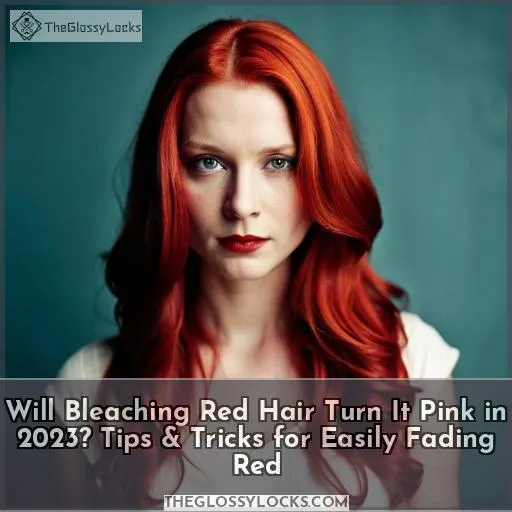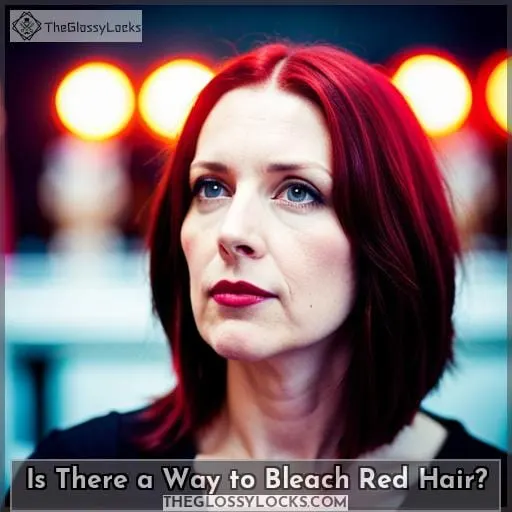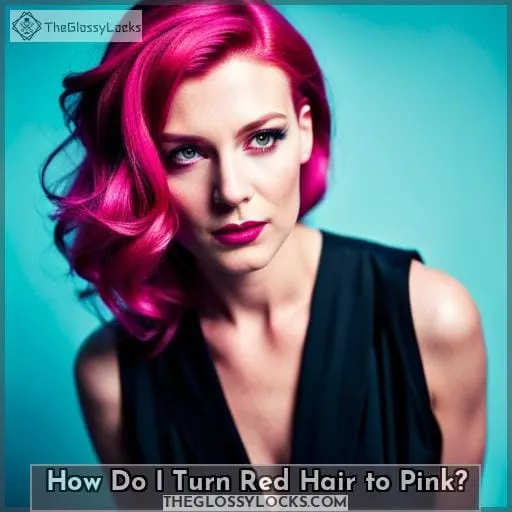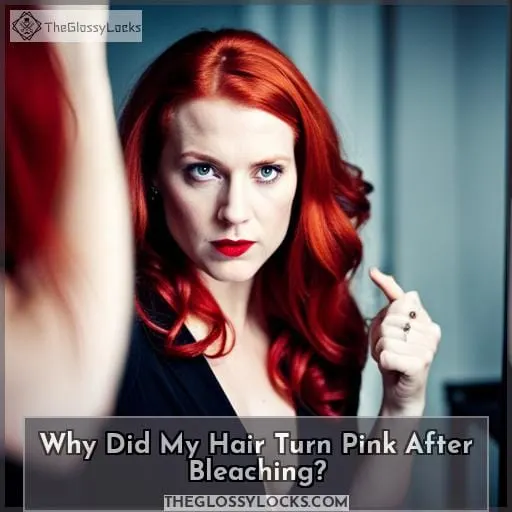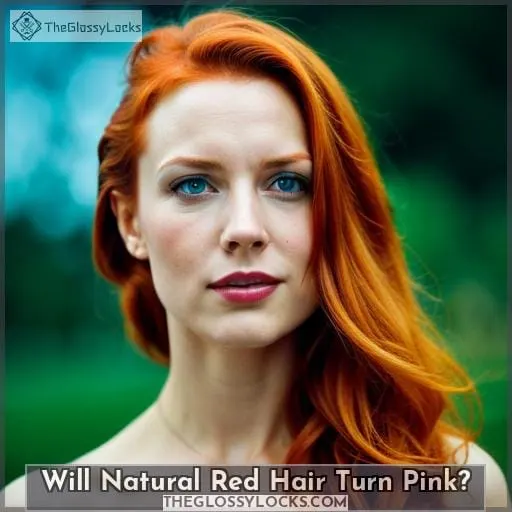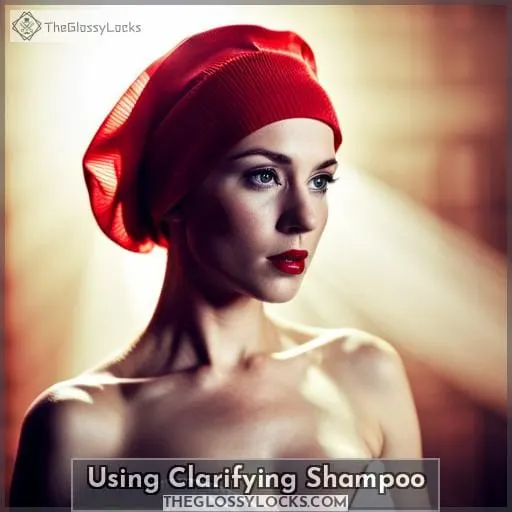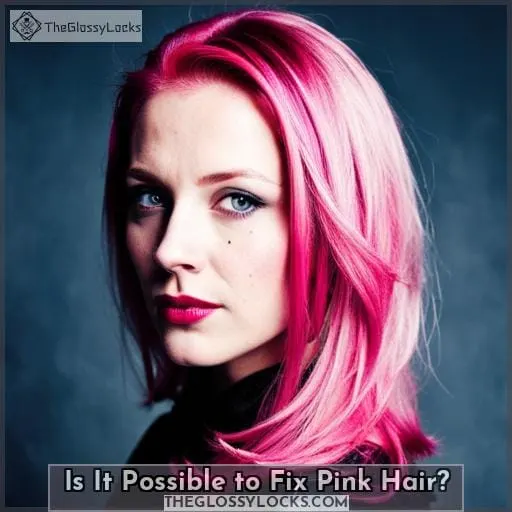This site is supported by our readers. We may earn a commission, at no cost to you, if you purchase through links.
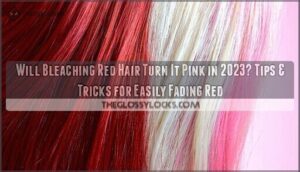 Are you tired of getting lots of attention for your red hair? If so, you may be considering lightening or turning it blonde. But don’t think that a simple dye job is the answer! Bleaching red dyed hair can be tricky, and if done incorrectly, it could end up leaving you with pink tresses instead.
Are you tired of getting lots of attention for your red hair? If so, you may be considering lightening or turning it blonde. But don’t think that a simple dye job is the answer! Bleaching red dyed hair can be tricky, and if done incorrectly, it could end up leaving you with pink tresses instead.
In this article, we will discuss whether bleaching red hair will turn it pink in 2023. We will also provide some tips and tricks to easily fade any unwanted color from your locks.
Table Of Contents
Key Takeaways
- Bleaching red-dyed hair can result in a pink hue if done incorrectly.
- Using a hair color remover can help correct unwanted pink tones.
- Purple shampoos and conditioners can help neutralize unwanted pink tones.
- Be cautious when using color removers as they can drastically change shade ranges.
Can I Use Hair Color Remover?
You may need to use a hair color remover if you find that your toning or bleaching results in an unexpected pink hue.
For example, one woman tried using clarifying shampoo but still found herself with bright pink locks; only after applying a green-based dye and toning shampoo did she finally achieve the desired yellow base.
If this happens to you while trying to go blonde, there are some steps for color correction that can help keep your hair hydrated and healthy throughout the process.
First, it’s important not to overcorrect: adding too much bleach immediately after bleaching could permanently damage your strands so be sure not to give up on clarifying shampoo just yet!
Clarifiers remove residue and product buildup from previous coloring attempts which can help get rid of any remaining red tones in the hair before continuing onto more drastic measures such as additional bleach applications or using a toner.
Additionally, try adding products specifically designed for colored/bleached hairs like purple shampoos or conditioners which will provide nourishment while neutralizing unwanted pink tones left behind by red dye during lightening processes – making them ideal companions when transitioning from dark colors (like deep burgundy) into lighter shades (such as honey blondes).
Finally, make sure you pay attention when using any type of color removers because they have strong chemical agents capable of drastically changing shade ranges quickly; regardless of whether it is removing existing hues like those derived from henna treatments or going even further until reaching natural pigments located within each individual strand – so take caution!
With patience and proper care, following these tips should ensure success when fixing dyed reddish tresses back into their original golden glory without turning them an undesired bubblegum pink hue instead!
Is There a Way to Bleach Red Hair?
If you’ve dyed your hair red and you’re now looking to transition back into a golden hue, there are some steps you can take to help ensure successful color correction. Bleaching is one method that can be used, though it should always be done with caution as using too much bleach could cause serious damage.
To begin the process safely, start by using a clarifying shampoo. This will help remove any remaining red tones in the hair before further lightening efforts continue. Additionally, incorporate products specifically designed for colored/bleached hair, such as purple toning shampoo or lemon juice.
These products will provide nourishment while neutralizing pink pigments left behind from previous dye attempts. They are ideal companions when transitioning from dark shades, like deep burgundy, into lighter tones, such as honey blondes.
Once this step has been completed and assessed correctly without overcorrecting or turning your locks green due to incorrect amounts of bleach applied, apply more carefully calculated quantities until reaching the desired yellow base results.
Finally, if all else fails, try utilizing green-based dyes combined with toning shampoos. These may offer additional assistance in achieving perfect colors without having suffered through irreversible damage.
- Use Clarifying Shampoo First
- Incorporate Color Safe Products
- Calculate Carefully Before Adding Bleach
- Avoid Overcorrection & Hair Damage
- Utilize Green Dye With Toning Shampoos
How Do I Turn Red Hair to Pink?
To transition from a deep red to pink, you must first clarify and nourish the hair before applying carefully calculated amounts of bleach. Start by using a clarifying shampoo, which will remove any remaining red tones in the hair strands.
Incorporate products specifically designed for colored or bleached hair, such as purple toning shampoo or lemon juice, to provide nourishment while neutralizing pink pigments left behind from previous dye attempts.
When calculating how much bleach is necessary, be sure not to take too long with this step so that your locks are not stripped away of vital nutrients during this process!
Once reaching the desired yellow base results, use green-based dyes combined with toning shampoos if necessary to further aid in achieving perfect colors without causing irreversible damage. You can also try other color-safe options like baking soda masks or Color Oops Hair Color Remover.
Follow this with a mixture of lemon juice and water applied directly onto dampened strands for up to 10 minutes before washing it out with blue shampoo afterwards.
Finally, pay attention when applying toner, as overcorrection may result in turning your locks green instead.
Why Did My Hair Turn Pink After Bleaching?
Bleaching your locks can cause an unexpected pink hue, so it’s important to be mindful of the steps you take. When attempting to lighten dark brown hair that has been dyed red, be aware that the bleach may react with the dye and turn it a shade of pink.
Fixing this issue is possible but requires caution and patience in order to avoid further damage or undesirable results.
Start by using a clarifying shampoo, which will help remove any product buildup or residue on your strands, as well as any remaining pigments from previous dyes.
If, after washing out all residue, no change occurs, then proceed with carefully calculated amounts of bleach, remembering not to leave it on for too long to preserve optimal nourishment – especially if color correction isn’t necessary!
Once reaching the desired yellow base levels, use green-based toners combined with purple shampoos when needed in order to neutralize those pesky pink tones still present.
Always pay attention when applying toner though – overcorrecting can lead to turning locks green instead of achieving the perfect colors desired.
Will Natural Red Hair Turn Pink?
While natural red hair may be beautiful, you must take extra care when attempting to lighten it as the bleaching process can lead to an unexpected pink hue. Hydrogen peroxide is a key component of many bleach formulas and can react with pre-colored hair in unpredictable ways.
The darker your existing undertones are, the more likely they will turn very light pink after bleaching.
Avoiding damage while achieving desired results requires patience and following proper steps.
Start by using a clarifying shampoo that will remove any remaining product buildup or residue on your strands, as well as any pigments from previous dyes before applying bleach again for color correction if necessary.
Afterward comes the toner step; green-based dye should be used in order to neutralize those pesky pink tones still present without risking turning locks green instead of rose gold tresses desired due mistakes made during application time like overcorrection or incorrect selection of products (green toning shampoos).
Baking soda masks and Color Oops Hair Color Remover are also viable options here for safe transitioning into lighter shades without causing irreversible harm!
To ensure complete protection against future issues resulting from these processes always remember: pay attention when applying toner correctly – don’t rush it – preserve optimal nourishment at all costs – never leave treatments on longer than recommended timespans – choose carefully between methods suggested above until right one found – go slow but steady throughout entire journey & enjoy transformation once finished successfully!
Using Clarifying Shampoo
If you’re attempting to lighten dyed red hair and the result is an unexpected pink hue, don’t panic! You can get your desired rose gold tresses with a few simple steps.
Firstly, use clarifying shampoo to remove any product buildup or residue that might be causing the color change.
Secondly, try bleaching your strands again – just make sure not to apply too much hydrogen peroxide for fear of further weakening already fragile hair.
Finally, tone out the pink by using a green-based dye or toning shampoo for optimal results without risking turning locks green instead of rose gold!
With patience and some careful attention given during application time, these processes will bring you closer towards achieving beautiful blonde hues in no time at all!
Use More Bleach
If the pink color still remains after using clarifying shampoo, try adding more bleach to get your desired yellow base. To avoid damage while bleaching, it’s important to pay attention during application time and follow instructions.
First, use apple cider vinegar or a strongly clarifying product to neutralize any leftover red pigments in hair. This will help ensure lighter shades are achieved without overcorrecting into darker ones.
Finally, remember that patience and consistency when following steps correctly will lead you towards achieving results safely!
Tone the Pink Out
To make your locks look luscious and vibrant, try toning out any pink hues with a green-based dye or a toning shampoo! Neutralizing tones can be achieved without causing hair damage by following the right steps.
First, identify which color you desire as your base to determine if more bleach is needed before using the chosen product. Select from an array of toners available for fixing reddish tones in red hair; this will help avoid overcorrecting into darker shades than intended.
Pay special attention during application of bleach and follow directions carefully to prevent weakening tresses or turning them green instead of rose gold! Afterward, use the appropriate products like clarifying shampoos that are specifically formulated for color fixing purposes and wash away all residue buildup in one go!
Finally, achieve salon-style results at home with patience while safely perfecting your desired shade – whether it’s blonde highlights or pastel pinks – through careful selection of bleaching agents combined with precise timing when applying these solutions on hair strands.
Is It Possible to Fix Pink Hair?
Fortunately, pink hair can easily be fixed with the right steps! On average, it takes about 45 minutes to correct hair that has been dyed an unexpected shade of pink.
To reduce damage and get your desired blonde hue, start by using a clarifying shampoo. This will help remove any product buildup or residue that may have caused the color change.
Then, add bleach to expose natural pigments in the hair and achieve an even yellow base for your color wheel.
Afterward, apply a green-based dye or toning shampoo, such as one containing blue pigments (for example, Joico Color Balance Blue Shampoo).
You may also opt for applying masks like Go Blonder Lightening Conditioner from John Frieda.
Finally, select a toner specifically designed to target blondes looking to rid themselves of unwanted warm tones. Wella Professionals Color Touch Relights Cool Blonde Toner is a good option. Wash out with cool water.
Frequently Asked Questions (FAQs)
How long should I leave bleach on my hair to turn it pink?
Leave bleach on your hair for a few minutes, but no longer than Monitor it carefully and rinse as soon as you achieve the desired pink hue – overbleaching can turn hair green! Use toner or dye if necessary to balance out any remaining color.
What is the best type of toner to use to neutralize pink tones?
To neutralize pink tones in your hair, use a green-based dye and toning shampoo. Apply a green mask first, then wash with the toner until you achieve the desired color.
Is it safe to use clarifying shampoo regularly?
No, it is not safe to use clarifying shampoo regularly. It can strip hair of nutrients and dry it out, so reserve its usage for when you need to remove residue or product buildup. Instead, opt for a more nourishing formula that will protect your hair’s natural health.
How can I avoid overcorrecting my hair to green?
Avoid overcorrecting to green hair by using clarifying shampoo first, then toning with a green-based dye. Pay close attention when applying the toner and use just enough for the desired results without going overboard.
How long will it take to fix my hair if it turned pink after bleaching?
Fixing your hair that turned pink after bleaching can take time, but with patience and focus, you can achieve the desired result. Utilizing clarifying shampoo to remove residue is key; then assess the remaining color before applying more bleach or toner.
Conclusion
It’s possible to fix pink hair that’s been caused by bleaching or toning. With patience and following the right steps, you can get back to your desired color.
A statistic that may be of interest is that up to 90% of hair color changes are due to damage from chemical processes.
The key to fixing the pink hair is to start with clarifying shampoo and assess the remaining color. If further bleach or toning is necessary, take your time to avoid overcorrecting the hair and causing further damage.
With the right care and attention, you can achieve the desired result.

